Pokemon theme by sowden 248
Download: Pokemon.p3t
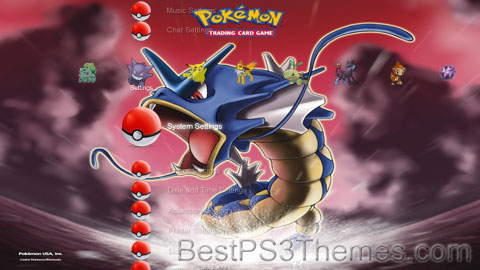
(5 backgrounds)
Redirect to:
This page is a redirect. The following categories are used to track and monitor this redirect:
|

The #1 spot for Playstation themes!
Pokemon theme by sowden 248
Download: Pokemon.p3t

(5 backgrounds)
Redirect to:
This page is a redirect. The following categories are used to track and monitor this redirect:
|
Superman theme by Megatron
Download: Superman_6.p3t
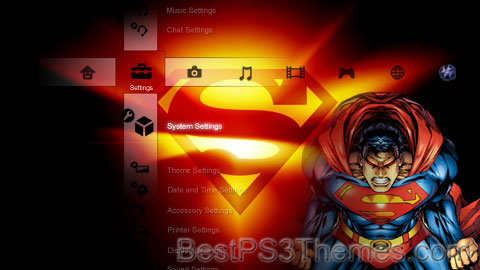
(1 background)
| Clark Kent / Kal-El Superman | |
|---|---|
 | |
| Publication information | |
| Publisher | DC Comics |
| First appearance | Action Comics #1 (cover-dated June 1938; published April 18, 1938) |
| Created by | Jerry Siegel (writer) Joe Shuster (artist) |
| In-story information | |
| Alter ego | Kal-El (birth name) Clark J. Kent (adopted name) |
| Species | Kryptonian |
| Place of origin | Krypton |
| Team affiliations | |
| Partnerships |
|
| Notable aliases |
|
| Abilities |
|
Superman is a superhero who appears in American comic books published by DC Comics. The character was created by writer Jerry Siegel and artist Joe Shuster, and debuted in the comic book Action Comics #1 (cover-dated June 1938 and published April 18, 1938).[1] Superman has been adapted to a number of other media, which includes radio serials, novels, films, television shows, theater, and video games.
Superman was born on the fictional planet Krypton with the birth name of Kal-El. As a baby, his parents sent him to Earth in a small spaceship shortly before Krypton was destroyed in a natural cataclysm. His ship landed in the American countryside near the fictional town of Smallville, Kansas. He was found and adopted by farmers Jonathan and Martha Kent, who named him Clark Kent. Clark began developing various superhuman abilities, such as incredible strength and impervious skin. His adoptive parents advised him to use his powers for the benefit of humanity, and he decided to fight crime as a vigilante. To protect his personal life, he changes into a colorful costume and uses the alias "Superman" when fighting crime. Clark resides in the fictional American city of Metropolis, where he works as a journalist for the Daily Planet. Superman's supporting characters include his love interest and fellow journalist Lois Lane, Daily Planet photographer Jimmy Olsen, and editor-in-chief Perry White, and his enemies include Brainiac, General Zod, and archenemy Lex Luthor.
Superman is the archetype of the superhero: he wears an outlandish costume, uses a codename, and fights evil with the aid of extraordinary abilities. Although there are earlier characters who arguably fit this definition, it was Superman who popularized the superhero genre and established its conventions. He was the best-selling superhero in American comic books up until the 1980s.[2]
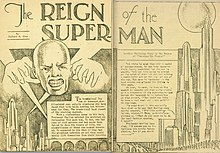
Jerry Siegel and Joe Shuster met in 1932 while attending Glenville High School in Cleveland and bonded over their admiration of fiction. Siegel aspired to become a writer and Shuster aspired to become an illustrator. Siegel wrote amateur science fiction stories, which he self-published as a magazine called Science Fiction: The Advance Guard of Future Civilization. His friend Shuster often provided illustrations for his work.[3] In January 1933, Siegel published a short story in his magazine titled "The Reign of the Superman". The titular character is a homeless man named Bill Dunn who is tricked by an evil scientist into consuming an experimental drug. The drug gives Dunn the powers of mind-reading, mind-control, and clairvoyance. He uses these powers maliciously for profit and amusement, but then the drug wears off, leaving him a powerless vagrant again. Shuster provided illustrations, depicting Dunn as a bald man.[4]
Siegel and Shuster shifted to making comic strips, with a focus on adventure and comedy. They wanted to become syndicated newspaper strip authors, so they showed their ideas to various newspaper editors. However, the newspaper editors told them that their ideas were insufficiently sensational. If they wanted to make a successful comic strip, it had to be something more sensational than anything else on the market. This prompted Siegel to revisit Superman as a comic strip character.[5][6] Siegel modified Superman's powers to make him even more sensational: Like Bill Dunn, the second prototype of Superman is given powers against his will by an unscrupulous scientist, but instead of psychic abilities, he acquires superhuman strength and bullet-proof skin.[7][8] Additionally, this new Superman was a crime-fighting hero instead of a villain, because Siegel noted that comic strips with heroic protagonists tended to be more successful.[9] In later years, Siegel once recalled that this Superman wore a "bat-like" cape in some panels, but typically he and Shuster agreed there was no costume yet, and there is none apparent in the surviving artwork.[10][11]
Siegel and Shuster showed this second concept of Superman to Consolidated Book Publishers, based in Chicago.[12][a] In May 1933, Consolidated had published a proto-comic book titled Detective Dan: Secret Operative 48.[13] It contained all-original stories as opposed to reprints of newspaper strips, which was a novelty at the time.[14] Siegel and Shuster put together a comic book in a similar format called The Superman. A delegation from Consolidated visited Cleveland that summer on a business trip and Siegel and Shuster took the opportunity to present their work in person.[15][16] Although Consolidated expressed interest, they later pulled out of the comics business without ever offering a book deal because the sales of Detective Dan were disappointing.[17][18]
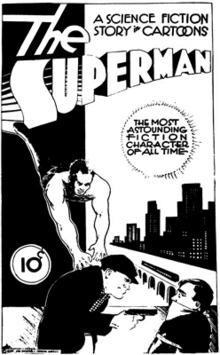
Siegel believed publishers kept rejecting them because he and Shuster were young and unknown, so he looked for an established artist to replace Shuster.[19] When Siegel told Shuster what he was doing, Shuster reacted by burning their rejected Superman comic, sparing only the cover. They continued collaborating on other projects, but for the time being Shuster was through with Superman.[20]
Siegel wrote to numerous artists.[19] The first response came in July 1933 from Leo O'Mealia, who drew the Fu Manchu strip for the Bell Syndicate.[21][22] In the script that Siegel sent to O'Mealia, Superman's origin story changes: He is a "scientist-adventurer" from the far future when humanity has naturally evolved "superpowers". Just before the Earth explodes, he escapes in a time-machine to the modern era, whereupon he immediately begins using his superpowers to fight crime.[23] O'Mealia produced a few strips and showed them to his newspaper syndicate, but they were rejected. O'Mealia did not send to Siegel any copies of his strips, and they have been lost.[24]
In June 1934, Siegel found another partner: an artist in Chicago named Russell Keaton.[25][26] Keaton drew the Buck Rogers and Skyroads comic strips. In the script that Siegel sent Keaton in June, Superman's origin story further evolved: In the distant future, when Earth is on the verge of exploding due to "giant cataclysms", the last surviving man sends his three-year-old son back in time to the year 1935. The time-machine appears on a road where it is discovered by motorists Sam and Molly Kent. They leave the boy in an orphanage, but the staff struggle to control him because he has superhuman strength and impenetrable skin. The Kents adopt the boy and name him Clark, and teach him that he must use his fantastic natural gifts for the benefit of humanity. In November, Siegel sent Keaton an extension of his script: an adventure where Superman foils a conspiracy to kidnap a star football player. The extended script mentions that Clark puts on a special "uniform" when assuming the identity of Superman, but it is not described.[27] Keaton produced two weeks' worth of strips based on Siegel's script. In November, Keaton showed his strips to a newspaper syndicate, but they too were rejected, and he abandoned the project.[28][29]
Siegel and Shuster reconciled and resumed developing Superman together. The character became an alien from the planet Krypton. Shuster designed the now-familiar costume: tights with an "S" on the chest, over-shorts, and a cape.[30][31][32] They made Clark Kent a journalist who pretends to be timid, and conceived his colleague Lois Lane, who is attracted to the bold and mighty Superman but does not realize that he and Kent are the same person.[33]

In June 1935 Siegel and Shuster finally found work with National Allied Publications, a comic magazine publishing company in New York owned by Malcolm Wheeler-Nicholson.[35] Wheeler-Nicholson published two of their strips in New Fun Comics #6 (1935): "Henri Duval" and "Doctor Occult".[36] Siegel and Shuster also showed him Superman and asked him to market Superman to the newspapers on their behalf.[37] In October, Wheeler-Nicholson offered to publish Superman in one of his own magazines.[38] Siegel and Shuster refused his offer because Wheeler-Nicholson had demonstrated himself to be an irresponsible businessman. He had been slow to respond to their letters and had not paid them for their work in New Fun Comics #6. They chose to keep marketing Superman to newspaper syndicates themselves.[39][40] Despite the erratic pay, Siegel and Shuster kept working for Wheeler-Nicholson because he was the only publisher who was buying their work, and over the years they produced other adventure strips for his magazines.[41]
Wheeler-Nicholson's financial difficulties continued to mount. In 1936, he formed a joint corporation with Harry Donenfeld and Jack Liebowitz called Detective Comics, Inc. in order to release his third magazine, which was titled Detective Comics. Siegel and Shuster produced stories for Detective Comics too, such as "Slam Bradley". Wheeler-Nicholson fell into deep debt to Donenfeld and Liebowitz, and in early January 1938, Donenfeld and Liebowitz petitioned Wheeler-Nicholson's company into bankruptcy and seized it.[3][42]
In early December 1937, Siegel visited Liebowitz in New York, and Liebowitz asked Siegel to produce some comics for an upcoming comic anthology magazine called Action Comics.[43][44] Siegel proposed some new stories, but not Superman. Siegel and Shuster were, at the time, negotiating a deal with the McClure Newspaper Syndicate for Superman. In early January 1938, Siegel had a three-way telephone conversation with Liebowitz and an employee of McClure named Max Gaines. Gaines informed Siegel that McClure had rejected Superman, and asked if he could forward their Superman strips to Liebowitz so that Liebowitz could consider them for Action Comics. Siegel agreed.[45] Liebowitz and his colleagues were impressed by the strips, and they asked Siegel and Shuster to develop the strips into 13 pages for Action Comics.[46] Having grown tired of rejections, Siegel and Shuster accepted the offer. At least now they would see Superman published.[47][48] Siegel and Shuster submitted their work in late February and were paid $130 (equivalent to $2,814 in 2023) for their work ($10 per page).[49] In early March they signed a contract at Liebowitz's request in which they gave away the copyright for Superman to Detective Comics, Inc. This was normal practice in the business, and Siegel and Shuster had given away the copyrights to their previous works as well.[50]
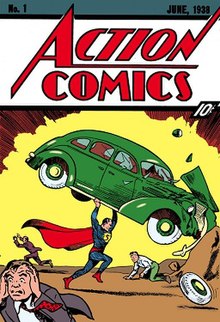
The duo's revised version of Superman appeared in the first issue of Action Comics, which was published on April 18, 1938. The issue was a huge success thanks to Superman's feature.[1][51][52]
Siegel and Shuster read pulp science-fiction and adventure magazines, and many stories featured characters with fantastical abilities such as telepathy, clairvoyance, and superhuman strength. One character in particular was John Carter of Mars from the novels by Edgar Rice Burroughs. John Carter is a human who is transported to Mars, where the lower gravity makes him stronger than the natives and allows him to leap great distances.[53][54] Another influence was Philip Wylie's 1930 novel Gladiator, featuring a protagonist named Hugo Danner who had similar powers.[55][56]
Superman's stance and devil-may-care attitude were influenced by the characters of Douglas Fairbanks, who starred in adventure films such as The Mark of Zorro and Robin Hood.[57] The name of Superman's home city, Metropolis, was taken from the 1927 film of the same name.[58] Popeye cartoons were also an influence.[58]
Clark Kent's harmless facade and dual identity were inspired by the protagonists of such movies as Don Diego de la Vega in The Mark of Zorro and Sir Percy Blakeney in The Scarlet Pimpernel. Siegel thought this would make for interesting dramatic contrast and good humor.[59][60] Another inspiration was slapstick comedian Harold Lloyd. The archetypal Lloyd character was a mild-mannered man who finds himself abused by bullies but later in the story snaps and fights back furiously.[61]
Kent is a journalist because Siegel often imagined himself becoming one after leaving school. The love triangle between Lois Lane, Clark, and Superman was inspired by Siegel's own awkwardness with girls.[62]
The pair collected comic strips in their youth, with a favorite being Winsor McCay's fantastical Little Nemo.[58] Shuster remarked on the artists who played an important part in the development of his own style: "Alex Raymond and Burne Hogarth were my idols – also Milt Caniff, Hal Foster, and Roy Crane."[58] Shuster taught himself to draw by tracing over the art in the strips and magazines they collected.[3]
As a boy, Shuster was interested in fitness culture[63] and a fan of strongmen such as Siegmund Breitbart and Joseph Greenstein. He collected fitness magazines and manuals and used their photographs as visual references for his art.[3]
The visual design of Superman came from multiple influences. The tight-fitting suit and shorts were inspired by the costumes of wrestlers, boxers, and strongmen. In early concept art, Shuster gave Superman laced sandals like those of strongmen and classical heroes, but these were eventually changed to red boots.[34] The costumes of Douglas Fairbanks were also an influence.[64] The emblem on his chest was inspired by heraldic crests.[65] Many pulp action heroes such as swashbucklers wore capes. Superman's face was based on Johnny Weissmuller with touches derived from the comic-strip character Dick Tracy and from the work of cartoonist Roy Crane.[66]
The word "superman" was commonly used in the 1920s and 1930s to describe men of great ability, most often athletes and politicians.[67] It occasionally appeared in pulp fiction stories as well, such as "The Superman of Dr. Jukes".[68] It is unclear whether Siegel and Shuster were influenced by Friedrich Nietzsche's concept of the Übermensch; they never acknowledged as much.[69]
Since 1938, Superman stories have been regularly published in periodical comic books published by DC Comics. The first and oldest of these is Action Comics, which began in April 1938.[1] Action Comics was initially an anthology magazine, but it eventually became dedicated to Superman stories. The second oldest periodical is Superman, which began in June 1939. Action Comics and Superman have been published without interruption (ignoring changes to the title and numbering scheme).[71][72] A number of other shorter-lived Superman periodicals have been published over the years.[73] Superman is part of the DC Universe, which is a shared setting of superhero characters owned by DC Comics, and consequently he frequently appears in stories alongside the likes of Batman, Wonder Woman, and others.
Superman has sold more comic books over his publication history than any other American superhero character.[74] Exact sales figures for the early decades of Superman comic books are hard to find because, like most publishers at the time, DC Comics concealed this data from its competitors and thereby the general public as well, but given the general market trends at the time, sales of Action Comics and Superman probably peaked in the mid-1940s and thereafter steadily declined.[75] Sales data first became public in 1960, and showed that Superman was the best-selling comic book character of the 1960s and 1970s.[2][76][77] Sales rose again starting in 1987. Superman #75 (Nov 1992) sold over 23 million copies,[78] making it the best-selling issue of a comic book of all time, thanks to a media sensation over the supposedly permanent death of the character in that issue.[79] Sales declined from that point on. In March 2018, Action Comics sold just 51,534 copies, although such low figures are normal for superhero comic books in general (for comparison, Amazing Spider-Man #797 sold only 128,189 copies).[80] The comic books are today considered a niche aspect of the Superman franchise due to low readership,[81] though they remain influential as creative engines for the movies and television shows. Comic book stories can be produced quickly and cheaply, and are thus an ideal medium for experimentation.[82]
Whereas comic books in the 1950s were read by children, since the 1990s the average reader has been an adult.[83] A major reason for this shift was DC Comics' decision in the 1970s to sell its comic books to specialty stores instead of traditional magazine retailers (supermarkets, newsstands, etc.) — a model called "direct distribution". This made comic books less accessible to children.[84]
Beginning in January 1939, a Superman daily comic strip appeared in newspapers, syndicated through the McClure Syndicate. A color Sunday version was added that November. Jerry Siegel wrote most of the strips until he was conscripted in 1943. The Sunday strips had a narrative continuity separate from the daily strips, possibly because Siegel had to delegate the Sunday strips to ghostwriters.[85] By 1941, the newspaper strips had an estimated readership of 20 million.[86] Joe Shuster drew the early strips, then passed the job to Wayne Boring.[87] From 1949 to 1956, the newspaper strips were drawn by Win Mortimer.[88] The strip ended in May 1966, but was revived from 1977 to 1983 to coincide with a series of movies released by Warner Bros.[89]
Initially, Siegel was allowed to write Superman more or less as he saw fit because nobody had anticipated the success and rapid expansion of the franchise.[90][91] But soon Siegel and Shuster's work was put under careful oversight for fear of trouble with censors.[92] Siegel was forced to tone down the violence and social crusading that characterized his early stories.[93] Editor Whitney Ellsworth, hired in 1940, dictated that Superman not kill.[94] Sexuality was banned, and colorfully outlandish villains such as Ultra-Humanite and Toyman were thought to be less nightmarish for young readers.[95]
Mort Weisinger was the editor on Superman comics from 1941 to 1970, his tenure briefly interrupted by military service. Siegel and his fellow writers had developed the character with little thought of building a coherent mythology, but as the number of Superman titles and the pool of writers grew, Weisinger demanded a more disciplined approach.[96] Weisinger assigned story ideas, and the logic of Superman's powers, his origin, the locales, and his relationships with his growing cast of supporting characters were carefully planned. Elements such as Bizarro, his cousin Supergirl, the Phantom Zone, the Fortress of Solitude, alternate varieties of kryptonite, robot doppelgangers, and Krypto were introduced during this era. The complicated universe built under Weisinger was beguiling to devoted readers but alienating to casuals.[97] Weisinger favored lighthearted stories over serious drama, and avoided sensitive subjects such as the Vietnam War and the American civil rights movement because he feared his right-wing views would alienate his left-leaning writers and readers.[98] Weisinger also introduced letters columns in 1958 to encourage feedback and build intimacy with readers.[99]
Weisinger retired in 1970 and Julius Schwartz took over. By his own admission, Weisinger had grown out of touch with newer readers.[100] Starting with The Sandman Saga, Schwartz updated Superman by making Clark Kent a television anchor, and he retired overused plot elements such as kryptonite and robot doppelgangers.[101] Schwartz also scaled Superman's powers down to a level closer to Siegel's original. These changes would eventually be reversed by later writers. Schwartz allowed stories with serious drama such as "For the Man Who Has Everything" (Superman Annual #11), in which the villain Mongul torments Superman with an illusion of happy family life on a living Krypton.
Schwartz retired from DC Comics in 1986 and was succeeded by Mike Carlin as an editor on Superman comics. His retirement coincided with DC Comics' decision to reboot the DC Universe with the companywide-crossover storyline "Crisis on Infinite Earths". In The Man of Steel writer John Byrne rewrote the Superman mythos, again reducing Superman's powers, which writers had slowly re-strengthened, and revised many supporting characters, such as making Lex Luthor a billionaire industrialist rather than a mad scientist, and making Supergirl an artificial shapeshifting organism because DC wanted Superman to be the sole surviving Kryptonian.
Carlin was promoted to Executive Editor for the DC Universe books in 1996, a position he held until 2002. K.C. Carlson took his place as editor of the Superman comics.
In the earlier decades of Superman comics, artists were expected to conform to a certain "house style".[102] Joe Shuster defined the
Iron Spiderman theme by JTF33
Download: IronSpiderman.p3t
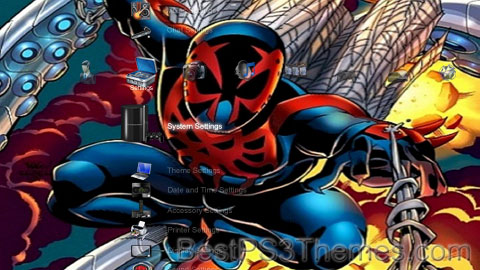
(16 backgrounds)
P3T Unpacker v0.12
Copyright (c) 2007. Anoop Menon
This program unpacks Playstation 3 Theme files (.p3t) so that you can touch-up an existing theme to your likings or use a certain wallpaper from it (as many themes have multiple). But remember, if you use content from another theme and release it, be sure to give credit!
Download for Windows: p3textractor.zip
Instructions:
Download p3textractor.zip from above. Extract the files to a folder with a program such as WinZip or WinRAR. Now there are multiple ways to extract the theme.
The first way is to simply open the p3t file with p3textractor.exe. If you don’t know how to do this, right click the p3t file and select Open With. Alternatively, open the p3t file and it will ask you to select a program to open with. Click Browse and find p3textractor.exe from where you previously extracted it to. It will open CMD and extract the theme to extracted.[filename]. After that, all you need to do for any future p3t files is open them and it will extract.
The second way is very simple. Just drag the p3t file to p3textractor.exe. It will open CMD and extract the theme to extracted.[filename].
For the third way, first put the p3t file you want to extract into the same folder as p3textractor.exe. Open CMD and browse to the folder with p3extractor.exe. Enter the following:
p3textractor filename.p3t [destination path]Replace filename with the name of the p3t file, and replace [destination path] with the name of the folder you want the files to be extracted to. A destination path is not required. By default it will extract to extracted.filename.
Owls Mixed theme by Owl
Download: OwlsMixedTheme.p3t
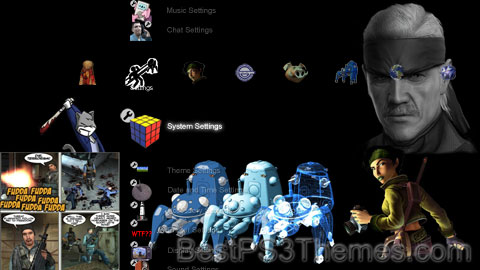
(1 background)
P3T Unpacker v0.12
Copyright (c) 2007. Anoop Menon
This program unpacks Playstation 3 Theme files (.p3t) so that you can touch-up an existing theme to your likings or use a certain wallpaper from it (as many themes have multiple). But remember, if you use content from another theme and release it, be sure to give credit!
Download for Windows: p3textractor.zip
Instructions:
Download p3textractor.zip from above. Extract the files to a folder with a program such as WinZip or WinRAR. Now there are multiple ways to extract the theme.
The first way is to simply open the p3t file with p3textractor.exe. If you don’t know how to do this, right click the p3t file and select Open With. Alternatively, open the p3t file and it will ask you to select a program to open with. Click Browse and find p3textractor.exe from where you previously extracted it to. It will open CMD and extract the theme to extracted.[filename]. After that, all you need to do for any future p3t files is open them and it will extract.
The second way is very simple. Just drag the p3t file to p3textractor.exe. It will open CMD and extract the theme to extracted.[filename].
For the third way, first put the p3t file you want to extract into the same folder as p3textractor.exe. Open CMD and browse to the folder with p3extractor.exe. Enter the following:
p3textractor filename.p3t [destination path]Replace filename with the name of the p3t file, and replace [destination path] with the name of the folder you want the files to be extracted to. A destination path is not required. By default it will extract to extracted.filename.
Norn Iron Simpsons v1.1 theme by JONNYRDG
Download: NornIronSimpsonsv1.1.p3t
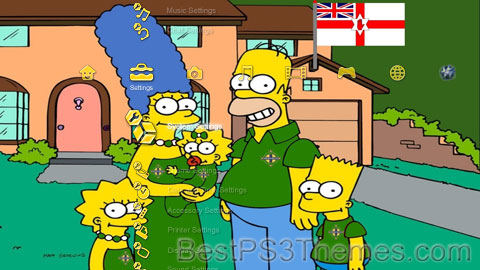
(1 background)
P3T Unpacker v0.12
Copyright (c) 2007. Anoop Menon
This program unpacks Playstation 3 Theme files (.p3t) so that you can touch-up an existing theme to your likings or use a certain wallpaper from it (as many themes have multiple). But remember, if you use content from another theme and release it, be sure to give credit!
Download for Windows: p3textractor.zip
Instructions:
Download p3textractor.zip from above. Extract the files to a folder with a program such as WinZip or WinRAR. Now there are multiple ways to extract the theme.
The first way is to simply open the p3t file with p3textractor.exe. If you don’t know how to do this, right click the p3t file and select Open With. Alternatively, open the p3t file and it will ask you to select a program to open with. Click Browse and find p3textractor.exe from where you previously extracted it to. It will open CMD and extract the theme to extracted.[filename]. After that, all you need to do for any future p3t files is open them and it will extract.
The second way is very simple. Just drag the p3t file to p3textractor.exe. It will open CMD and extract the theme to extracted.[filename].
For the third way, first put the p3t file you want to extract into the same folder as p3textractor.exe. Open CMD and browse to the folder with p3extractor.exe. Enter the following:
p3textractor filename.p3t [destination path]Replace filename with the name of the p3t file, and replace [destination path] with the name of the folder you want the files to be extracted to. A destination path is not required. By default it will extract to extracted.filename.
Elektra theme by myownscars
Download: Elektra.p3t
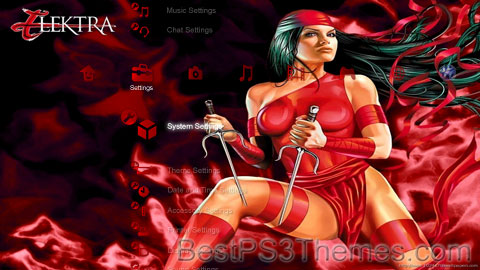
(1 background)
Redirect to:
This page is a redirect. The following categories are used to track and monitor this redirect:
|
Anime Baby 4 theme by E-machines
Download: AnimeBaby4.p3t
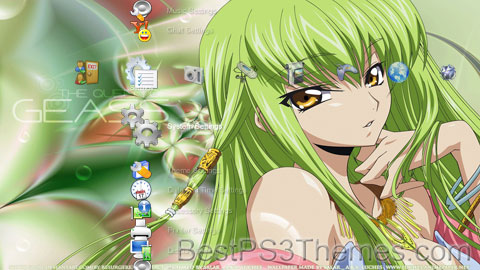
(1 background)
P3T Unpacker v0.12
Copyright (c) 2007. Anoop Menon
This program unpacks Playstation 3 Theme files (.p3t) so that you can touch-up an existing theme to your likings or use a certain wallpaper from it (as many themes have multiple). But remember, if you use content from another theme and release it, be sure to give credit!
Download for Windows: p3textractor.zip
Instructions:
Download p3textractor.zip from above. Extract the files to a folder with a program such as WinZip or WinRAR. Now there are multiple ways to extract the theme.
The first way is to simply open the p3t file with p3textractor.exe. If you don’t know how to do this, right click the p3t file and select Open With. Alternatively, open the p3t file and it will ask you to select a program to open with. Click Browse and find p3textractor.exe from where you previously extracted it to. It will open CMD and extract the theme to extracted.[filename]. After that, all you need to do for any future p3t files is open them and it will extract.
The second way is very simple. Just drag the p3t file to p3textractor.exe. It will open CMD and extract the theme to extracted.[filename].
For the third way, first put the p3t file you want to extract into the same folder as p3textractor.exe. Open CMD and browse to the folder with p3extractor.exe. Enter the following:
p3textractor filename.p3t [destination path]Replace filename with the name of the p3t file, and replace [destination path] with the name of the folder you want the files to be extracted to. A destination path is not required. By default it will extract to extracted.filename.
Daredevil theme by myownscars
Download: Daredevil.p3t
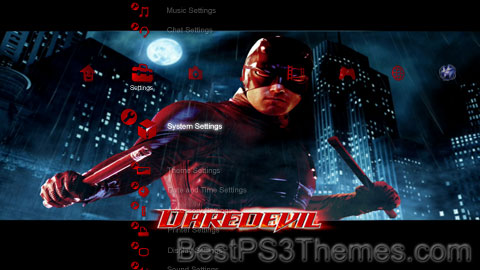
(5 backgrounds)
Daredevil may refer to:
Comic Batman theme by myownscars
Download: ComicBatman.p3t

(6 backgrounds)
P3T Unpacker v0.12
Copyright (c) 2007. Anoop Menon
This program unpacks Playstation 3 Theme files (.p3t) so that you can touch-up an existing theme to your likings or use a certain wallpaper from it (as many themes have multiple). But remember, if you use content from another theme and release it, be sure to give credit!
Download for Windows: p3textractor.zip
Instructions:
Download p3textractor.zip from above. Extract the files to a folder with a program such as WinZip or WinRAR. Now there are multiple ways to extract the theme.
The first way is to simply open the p3t file with p3textractor.exe. If you don’t know how to do this, right click the p3t file and select Open With. Alternatively, open the p3t file and it will ask you to select a program to open with. Click Browse and find p3textractor.exe from where you previously extracted it to. It will open CMD and extract the theme to extracted.[filename]. After that, all you need to do for any future p3t files is open them and it will extract.
The second way is very simple. Just drag the p3t file to p3textractor.exe. It will open CMD and extract the theme to extracted.[filename].
For the third way, first put the p3t file you want to extract into the same folder as p3textractor.exe. Open CMD and browse to the folder with p3extractor.exe. Enter the following:
p3textractor filename.p3t [destination path]Replace filename with the name of the p3t file, and replace [destination path] with the name of the folder you want the files to be extracted to. A destination path is not required. By default it will extract to extracted.filename.
Ghost Rider theme by Huayagedishy
Download: GhostRider_2.p3t
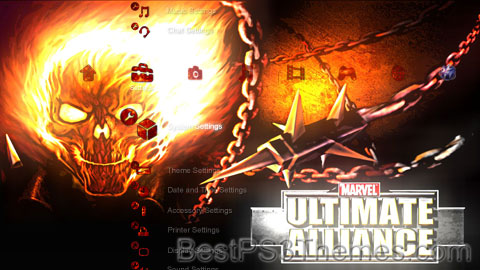
(1 background)
| Ghost Rider | |
|---|---|
 Ghost Rider on the cover of Marvel Spotlight #5 (Aug. 1972). | |
| Publication information | |
| Publisher | Marvel Comics |
| First appearance | Marvel Spotlight #5 (August 1972) |
| Created by | |
| In-story information | |
| Alter ego |
|
| Species | Human/demon hybrid |
| Team affiliations |
|
| Notable aliases |
|
| Abilities |
|
Ghost Rider is the name of multiple superheroes or antiheroes appearing in American comic books published by Marvel Comics. Marvel had previously used the name for a Western character whose name was later changed to Phantom Rider.
The first supernatural Ghost Rider is stunt motorcyclist Johnny Blaze, who sold his soul, to save the life of his foster father, agrees to give his soul to "Satan" (later revealed to be an arch-demon named Mephisto). At night and when around evil, Blaze finds his flesh consumed by hellfire, causing his head to become a flaming skull. He rides a fiery motorcycle and wields blasts of hellfire from his body, usually from his skeletal hands. He eventually learns he has been bonded with the demon Zarathos. Blaze is featured in the series Ghost Rider (vol. 2) from 1972 to 1983.
The subsequent Ghost Rider series (1990–1998) features Danny Ketch as a new Ghost Rider. After his sister was injured by ninja gangsters, Ketch comes in contact with a motorcycle that contains the essence of a Spirit of Vengeance. Blaze reappears in this 1990s series as a supporting character, and it is later revealed that Danny and his sister were Johnny Blaze's long-lost siblings. In 2000s comics, Blaze succeeds Ketch, becoming Ghost Rider again. In 2014, Robbie Reyes becomes Ghost Rider as part of the Marvel NOW! initiative.
In May 2011, Ghost Rider placed 90th on IGN's "Top 100 Comic Book Heroes" list.[1] Nicolas Cage starred as the Johnny Blaze incarnation of the character in the 2007 film Ghost Rider and its 2012 sequel, Ghost Rider: Spirit of Vengeance. Gabriel Luna and Tom McComas portray the Robbie Reyes and Johnny Blaze incarnations in the fourth season of the Marvel Cinematic Universe (MCU) television series Agents of S.H.I.E.L.D., with Henry Simmons and Clark Gregg portraying original incarnations Alphonso Mackenzie and Phil Coulson.
Following the Western comics character who originally used the name, the first superhero Ghost Rider, Johnny Blaze, debuted in Marvel Spotlight issue #5 (Aug. 1972), created by Marvel editor-in-chief Roy Thomas,[2] writer Gary Friedrich and artist Mike Ploog. He received his own series in 1973, with penciller Jim Mooney handling most of the first nine issues. Several different creative teams mixed-and-matched until penciller Don Perlin began a considerably long stint with issue #26, eventually joined by writer Michael Fleisher through issue #58. The series ran through issue #81 (June 1983). Blaze returned as Ghost Rider in a 2001 six-issue miniseries written by Devin Grayson; a second miniseries written by Garth Ennis in 2005, and an ongoing monthly series that began publication in July 2006. Johnny Blaze was the son of Naomi Blaze and Barton Blaze. Naomi was the previous Ghost Rider.
The next Ghost Rider, a young man named Daniel "Danny" Ketch (Johnny Blaze's long-lost younger brother), debuted in Ghost Rider (vol. 3) #1 (May 1990). This Ghost Rider was nearly identical to the previous, although his costume was now a black leather biker jacket with spiked shoulder-pads, grey leather pants, and a mystic chain he wore across his chest, which responded to his mental commands and served as his primary melee weapon. His new motorcycle resembled a futuristic machine and the front of it could lower to serve as a battering ram. Like the original Ghost Rider's bike, the wheels were composed of mystic hellfire. Unlike the relationship between the previous Ghost Rider and the demon with which he was bonded, Ketch and his demon — who in (vol. 3) #91 (Dec. 1997) is revealed to be Marvel's incarnation of the Angel of Death/Judgment — are cooperative with each other. At the close of the series with (vol. 3) #93 (Feb. 1998), Ketch apparently died. The following year, however, Peter Parker: Spider-Man #93 (July 1999) revealed Ketch was still alive. Nearly a decade later, Marvel published the long-completed final issue as Ghost Rider Finale (Jan. 2007), which reprints the last issue and the previously unpublished Ghost Rider (vol. 3) #94.[3]
During the 2011 storyline "Fear Itself", a Nicaraguan woman named Alejandra Jones becomes Ghost Rider through a ritual performed by a man named Adam. Though she demonstrates many previously unknown powers of the Ghost Rider entity, she is deprived of its full power when Johnny Blaze takes back most of this power in (Vol. 7) #9. She was killed by Carnage during the Absolute Carnage event.
In 2014, a new character took on the Ghost Rider mantle: a Mexican-American resident of East Los Angeles named Roberto "Robbie" Reyes, who drives a black classic muscle car reminiscent of a modified 1969 Dodge Charger rather than a motorcycle.[4][5] Robbie Reyes was created by writer/artist Felipe Smith and designed by Smith and artist Tradd Moore.[6]
Michael Badilino, an ex-member of the New York City Police Department, is one-third of an "Organic Medallion of Power"; the other two are Ketch and Blaze (the Medallion itself was never explained in any true detail). He possesses powers more in line with those of the Zarathos version of Ghost Rider, although he also possesses the Penance Stare and his motorcycle seemed to share characteristics with the Noble Kale version. His appearance is distinguished by a deep purple skull, large fangs protruding from his upper jaw, and backswept curved horns on the top of his skull.
In his superhuman form, Badilino was called Vengeance, and originally attempted to kill the Ghost Rider, believing him to be Zarathos. Vengeance later became the ally of Ghost Rider and Johnny Blaze. Vengeance also took on the role of the Ghost Rider and even semi-seriously referred to himself by that name when confronted by Spider-Man shortly after the apparent death of Ghost Rider in battle with Zarathos and acolytes The Fallen. Vengeance killed himself, along with the villain Hellgate, by triggering a massive explosion through his Hellfire, the source of the mystical flames that encompass the bones of both Vengeance and Ghost Rider.
Vengeance reappears in the last four issues of Ghost Rider (vol. 3), involved in Blackheart's plans to kill Noble Kale. Vengeance aids the Ghost Rider in the ensuing battle, destroying Blackheart and ruling Hell during Ketch's absences.
In the 19th century, while her tribe was being attacked by the U.S. Army, Kushala's parents were killed and, in an act of rage, she prayed to her creator, but instead was possessed by a Spirit of Vengeance. Then she burnt everyone until all that remained were their spirits. After becoming possessed by the Spirit of Vengeance, Kushala traveled the world seeking out and studying different forms of magic in an attempt to cure herself. Her skills in the mystic arts eventually led to her becoming the Sorcerer Supreme of her era.
The Ghost Rider is a human who can transform into a skeletal superhuman wreathed in ethereal flame and given supernatural powers. The abnormal motorcycle he rides can travel faster than any conventional vehicle and perform impossible feats such as riding up a vertical surface, across water, and leaping across great distances that normal motorcycles cannot. The Ghost Riders are virtually indestructible and notoriously hard to injure by any conventional means, as bullets and knives usually pass through them without causing pain (knives are shown to melt while in their body).[7] It is possible that they are genuinely immortal, as it is said that God created them and only God can destroy them.[8] Despite being composed of bone and hellfire, the Ghost Riders possess formidable superhuman strength, enough to easily pick up a truck and hurl it across a road. It has been stated that Johnny Blaze as Ghost Rider can bench press around 25 tons (50,000 lbs) (or more as seen in World War Hulk).[9] Each Ghost Rider entity also had abilities specific to him or her.
Naomi Kale is the mother of Johnny Blaze, Danny Ketch, and Barbara Ketch.
Noble lived in the 18th century and grew up with his abusive father Pastor Kale and his younger brother Dante.
Noble fell in love with a black girl named Magdelena. But, because of the color of her skin and his father's strong religious views, the couple kept their love a secret from the world. They were forced to tell Pastor Kale when Magdelena bore Noble's child. Noble and Magdelena were then married.
Shortly after the marriage, Magdelena discovered Pastor Kale's dark secret; he was a servant of the dark lord Mephisto. To cover up Magdelena's findings, Pastor Kale accused her of witchcraft and had her burned at the stake. Knowing that his son, Noble, would object, he had him drugged, tortured and beaten in the church cellar.
Just before Magdelena died, she used a curse to summon demons that avenge wronged women. The demons were called "Furies" and they started killing the townspeople. Fearing death, Pastor Kale struck a deal with Mephisto. In return for his safety, Mephisto got Noble's soul. Mephisto realized that Noble was attached to a piece of the Medallion of Power and he activated the piece to transform Noble into the original "Spirit of Vengeance". When Ghost Rider had destroyed the Furies, Pastor offered him human flesh - Noble's son. Noble, in the guise of Ghost Rider, was unwilling to eat his own child and he killed himself.
When Mephisto later appeared to claim Noble's soul, Mephisto's brother, the archangel Uriel, appeared and demanded that the soul of Noble Kale be spared. No agreement could be reached, and therefore a compromise was made whereby Noble's soul could not be claimed by either realm; but instead, his soul would remain in the void until re-bonded with certain members of his family.[13]
Noble Kale was also established as an ancestor of Jennifer Kale.[14]
Due to the Celestial Progenitor presence influencing human evolution, in 1,000,000 B.C., certain humans became much more intelligent than others as well as able to speak a new language. However, they had to hide that gift from their brethren for fear of being ostracized. One day, a boy that was gifted with the ability to speak is approached by a mysterious stranger that also possessed that gift, only to witness the stranger transform into a beast and devour his entire tribe. The stranger allowed the boy to live and names him "Ghost" before telling him to challenge him when he is worthy. The boy was forced to survive on his own, though he does befriend a woolly mammoth. After almost dying in the harsh environment, he is approached by Mephisto in the form of a snake, who tells him to say its name. Ghost does that and is bonded with a Spirit of Vengeance; after which he imbued his newly acquired hellfire into the mammoth. Other humans had never seen someone ride an animal before and began referring to Ghost as "the Rider". The Rider continued his search and five years later, eventually caught up with the man who devoured his tribe. The man transformed once more, revealing himself to be the first Wendigo. During the fight, the Rider took the bones of the dead that the Wendigo had killed and used them to form a weapon; the earliest version of the Ghost Rider's signature chain. The Rider fought the Wendigo until finally it and the Rider's woolly mammoth tumbled over a cliff. Afterwards, Ghost was approached by Odin and Lady Phoenix to join the prehistoric version of the Avengers.[15]
Upon imbuing his hellfire into another woolly mammoth, the Ghost Rider assisted the prehistoric Avengers (consisting of Agamotto, Odin, Lady Phoenix, and prehistoric versions of the Black Panther, Iron Fist, and Star Brand) in fighting an out of control Celestial called the Fallen; which resulted in his woolly mammoth getting killed in action. The Ghost Rider swore revenge and assisted his teammates in defeating the Fallen and sealing it away underground in what would become South Africa.[11] The Ghost Rider later assisted the prehistoric Avengers in fighting the First Host.[16]
During the 11th century, a Native American chieftain from the Sioux nation named Hellhawk sported the powers of the Ghost Rider. He was part of Thor's Avengers of 1,000 A.D.[17][18]
During the 17th century, Hellhawk developed a rivalry with Noble Kane.[19] He was later killed by Narcosis to serve as a warning to Mephisto by Belasco to keep his Spirits of Vengeance out of Limbo.[20]
Seven riders show their flaming heads for the first time in this story arc by writer Jason Aaron and artist Tan Eng Huat. Daniel Ketch returns with a new mission: to collect the powers of all the Ghost Riders for the angel Zadkiel to prevent the corruption of the powers with their human hosts. Zadkiel has other motives he keeps to himself, for which he needs the powers of the riders to tear down the walls of New Jerusalem and wage war on the heavens.
A version of Ghost Rider appeared in the miniseries Ghost Rider: Trail of Tears #1–6 (April–Sept. 2007) by writer Garth Ennis and artist Clayton Crain. Set during the American Civil War, it finds Confederate officer Travis Parham avenging the murders of his friend, an ex-slave named Caleb and Caleb's family. Parham meets a horse-riding Ghost Rider who seeks the same men. Eventually, Parham learns about the deaths instrumental in helping set forth the Spirit of Vengeance.
During the 19th century, an unnamed Ghost Rider was active during the American frontier. He targeted anyone who killed Native American women and children or who cut off their scalps.[19]
Deputy Kowalski was a normal cop in a small town until Ghost Rider rode in one day. It was then that Kowalski was kidnapped by a local cannibal who cut off his hand. Events transpired that led to Kowalski escaping and developing a wrath against the Ghost Rider. His attention was brought to the hellfire shotgun in possession of Badilino. After purchasing the gun—and discovering to Badilino's surprise that it will work for Kowalski—Kowalski was recruited by agents of Zadkiel and told to wait in the middle of the desert for the Ghost Rider. Johnny Blaze (as Ghost Rider) did arrive in hot pursuit of Danny Ketch (as a new incarnation of Ghost Rider). Kowalski did manage to get a shot in on Blaze. Although it was a minor setback Blaze resumed his pursuit of Ketch. Left in the desert Kowalski soon found himself transformed into the new Vengeance, sporting green flames and a hook for his right hand, after Ketch returned the powers of the Spirits of Vengeance to Earth.[volume & issue needed]
With a thirst for revenge, Kowalski, as Vengeance, was recruited by Blackout as a member of Zadkiel's Ghost Rider Assassination League.[21] Kowalski was partnered with The Orb and was to stop Blaze and Ketch from reaching a monastery which contained a gateway to Heaven. Kowalski was easily defeated by both Ghost Riders and was left as a pet with the monastery's Mother Superior.[22]
Vengeance was later freed by the Shadow Council and joins the ninth incarnation of the Masters of Evil.[23]